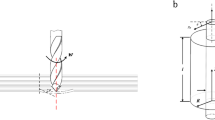Abstract
Stacking plates of CFRP composite materials are increasingly used because of their unique characteristics. However, unlike other materials used in metallurgy they have a disadvantage of uneven quality and anisotropy when combined with other composites. Hence, specimens of CFRP stacking plates are manufactured by changing orientation angles throughout three quasi-isotropic plies (0°/45°/90°/−45°)6 s , (03°/453°/903°/−453°)2 s , and (06°/456°/906°/−456°) s and throughout three cross plies (0°/90°/0°/90°)6 s ,(03°/903°/03 °/903°)2s, and (06°/906°/06°/906°) s . In this study 3-point bending tests and transverse bending tests have been carried out in order to find out mechanical characteristics according to orientation angles by stacking in 6 different types along with the change of stacking composition method of a CFRP composite.
Similar content being viewed by others
References
Malick, P.K., Fiber-Reinforced Composites, Marcel Dekker, Inc., 1988, 3–4.
Jcantwell, W.J. and Morton, J., Detection of impact damage in CFRP laminates. Composites Structures, 1985, 3: 241–257.
Reugg, C. and Habermeir, J., Composite propeller shaft Design and optimization advances in composite material. Advances in Composite Material Processings of ICCM 3, 1980, 2: 1740–1755.
Ramulu, M. and Arola, D., The Influence of abrasive waterjet cutting conditions on the surface quality of graphite/epoxy laminates. International Journal of Machine Tools and Manufacture, 1994, 34: 295–313.
Cantwell, W.J. and Morton, J., Residual strength assessment of impact damaged CFRP laminates. Proc. Int. Conf. Post-Failure Analysis of Fiber Reinforced Composites, Dayton, Ohio, July 1985.
Caprino, G., Tagliaferri, V. and Covelli, L., Cutting glass fiber reinforce composites using CO2 laser with multimodal-gaussian distribution. International Journal of Machine Tools and Manufacture, 1995, 35: 831–840.
Koenig, W. and Grass, P., Quality definition and assessment in drilling of fiber reinforced thermosets. Annals of the CIRP, 1989, 38(1): 119–124.
Chen Wen-Chou, Some experimental investigations in the drilling of carbon fiber-reinforced plastics composite laminates. International Journal of Machine Tools and Manufacture, 1997, 37(8): 639–650.
Radhakrishnan, T. and Wu, S.M., On-line hole quality evaluation for drilling composite material using dynamic data. Transactions Of the ASME, Journal of Engineering for Industry, 1981, 103: 119–125.
Koenig, W., Wulf, C., Grass, P. and Willersheid, H., Quality definition and assessment in drilling of fiber reinforced thermosets. Annals of the CIRP, 1985, 34(2): 537–548.
Caprino, G. and Tagliaferri, V., Damage development drilling glass fiber reinforced plastics. International Journal of Machine Tools and Manufacture, 1995, 35(6): 817–829.
Author information
Authors and Affiliations
Corresponding author
Rights and permissions
About this article
Cite this article
Lee, SC., Jeong, ST., Park, JN. et al. Study on Drilling Characteristics and Mechanical Properties of CFRP Composites. Acta Mech. Solida Sin. 21, 364–368 (2008). https://doi.org/10.1007/s10338-008-0844-z
Received:
Published:
Issue Date:
DOI: https://doi.org/10.1007/s10338-008-0844-z




